LINCOLN MKZ HYBRID 2013 Owners Manual
Manufacturer: LINCOLN, Model Year: 2013, Model line: MKZ HYBRID, Model: LINCOLN MKZ HYBRID 2013Pages: 475, PDF Size: 3.89 MB
Page 161 of 475
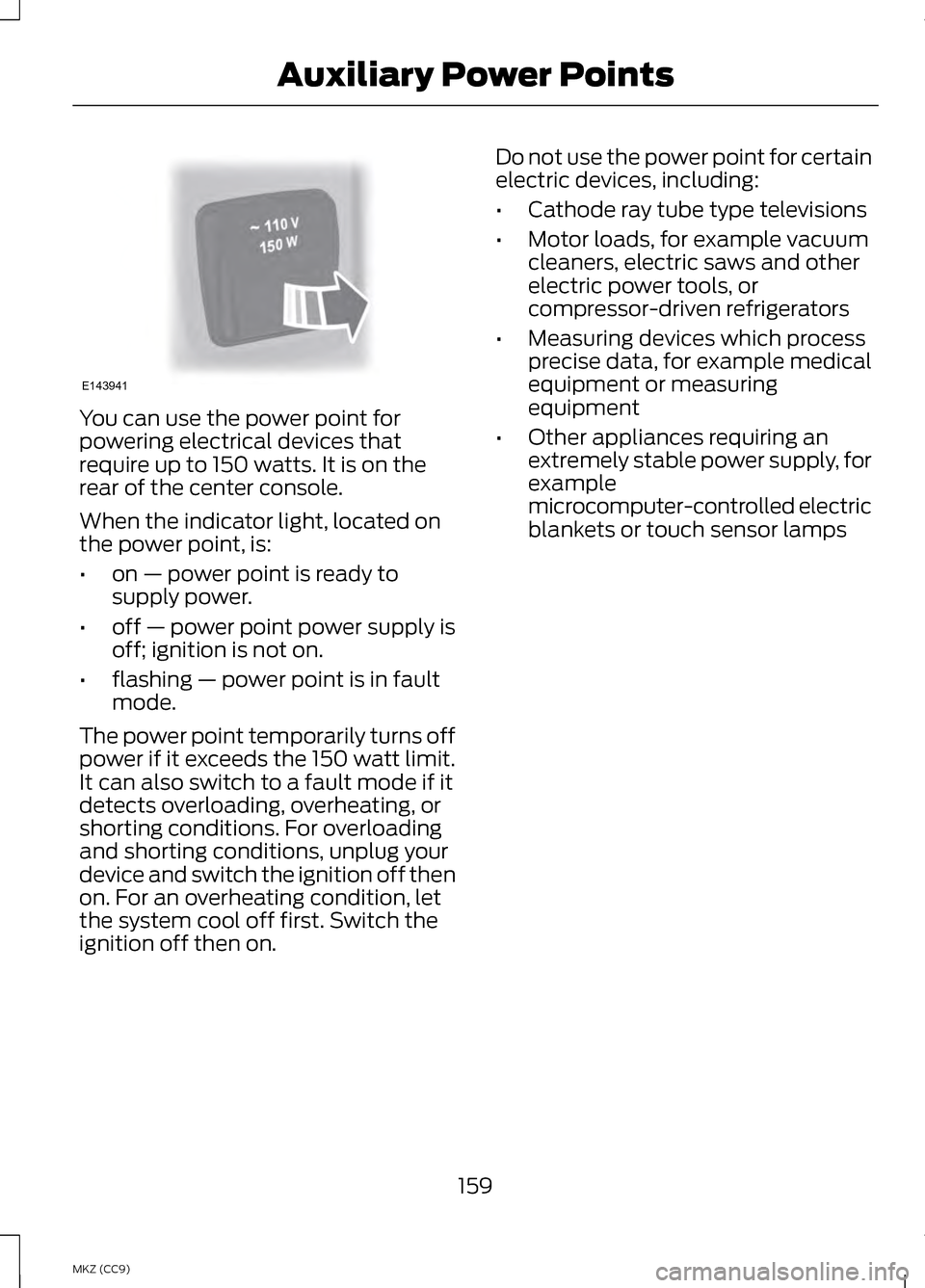
You can use the power point for
powering electrical devices that
require up to 150 watts. It is on the
rear of the center console.
When the indicator light, located on
the power point, is:
•
on — power point is ready to
supply power.
• off — power point power supply is
off; ignition is not on.
• flashing — power point is in fault
mode.
The power point temporarily turns off
power if it exceeds the 150 watt limit.
It can also switch to a fault mode if it
detects overloading, overheating, or
shorting conditions. For overloading
and shorting conditions, unplug your
device and switch the ignition off then
on. For an overheating condition, let
the system cool off first. Switch the
ignition off then on. Do not use the power point for certain
electric devices, including:
•
Cathode ray tube type televisions
• Motor loads, for example vacuum
cleaners, electric saws and other
electric power tools, or
compressor-driven refrigerators
• Measuring devices which process
precise data, for example medical
equipment or measuring
equipment
• Other appliances requiring an
extremely stable power supply, for
example
microcomputer-controlled electric
blankets or touch sensor lamps
159
MKZ (CC9) Auxiliary Power PointsE143941
Page 162 of 475
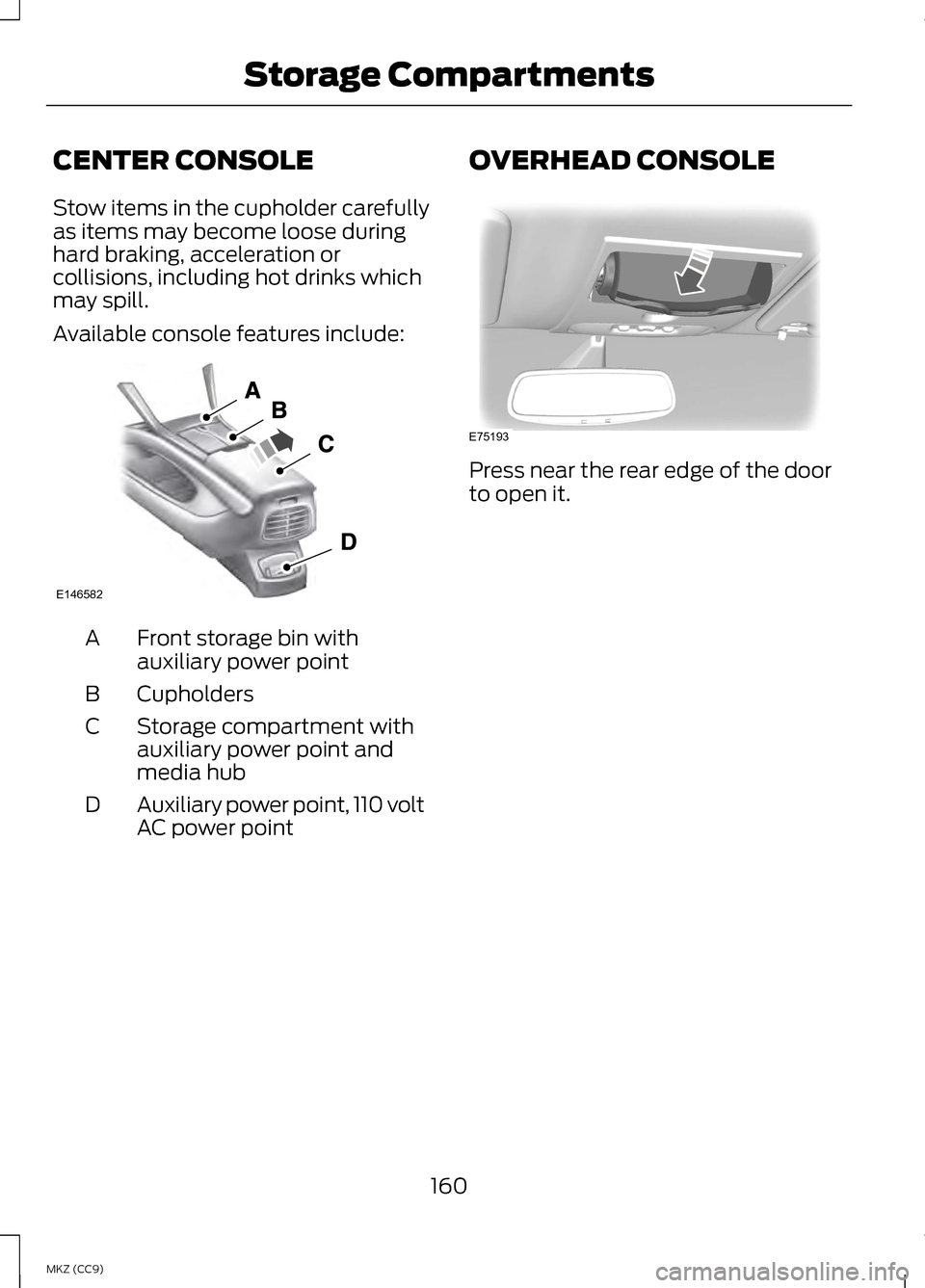
CENTER CONSOLE
Stow items in the cupholder carefully
as items may become loose during
hard braking, acceleration or
collisions, including hot drinks which
may spill.
Available console features include:
Front storage bin with
auxiliary power point
A
Cupholders
B
Storage compartment with
auxiliary power point and
media hub
C
Auxiliary power point, 110 volt
AC power point
D OVERHEAD CONSOLE Press near the rear edge of the door
to open it.
160
MKZ (CC9) Storage CompartmentsE146582 E75193
Page 163 of 475
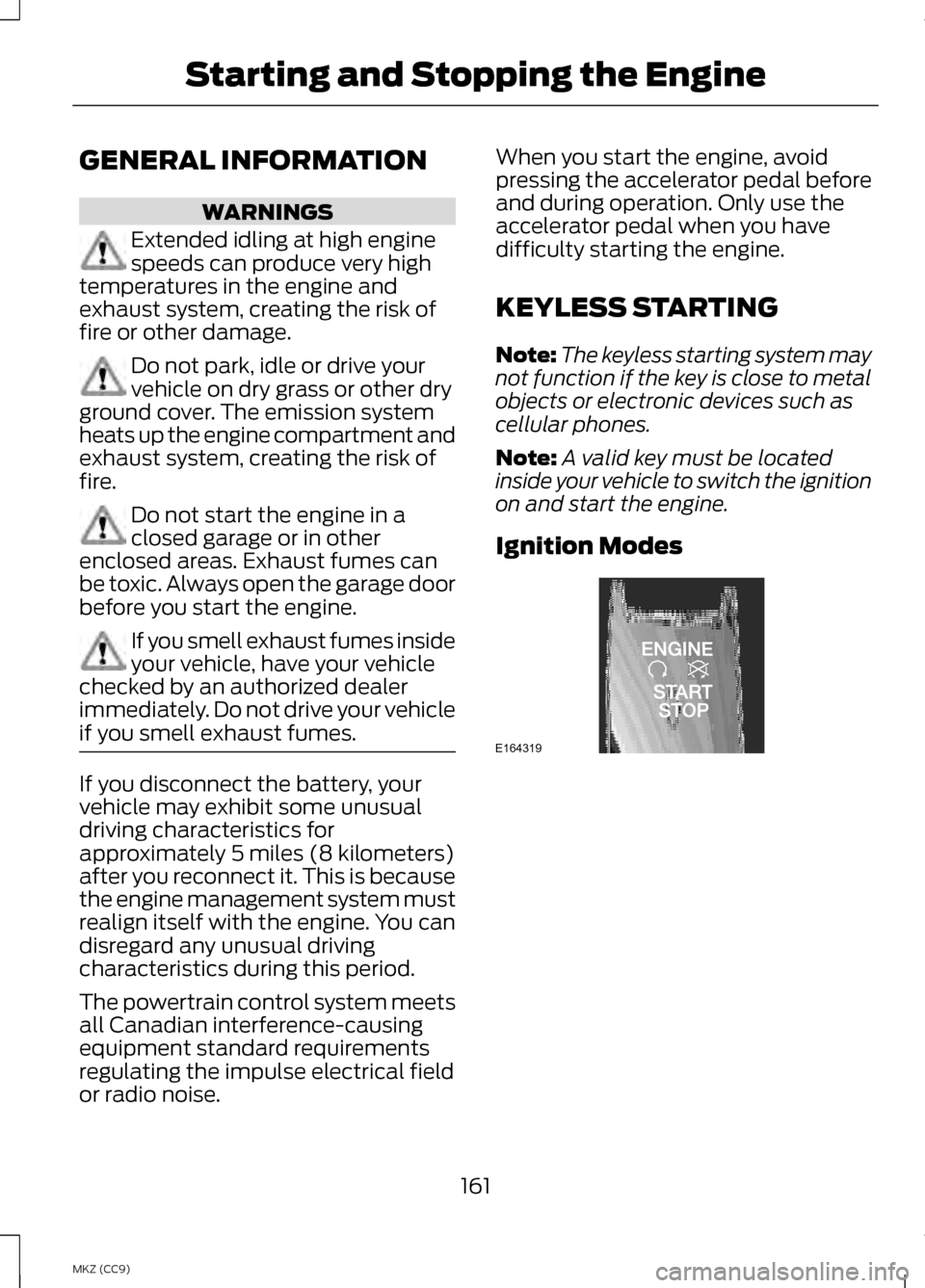
GENERAL INFORMATION
WARNINGS
Extended idling at high engine
speeds can produce very high
temperatures in the engine and
exhaust system, creating the risk of
fire or other damage. Do not park, idle or drive your
vehicle on dry grass or other dry
ground cover. The emission system
heats up the engine compartment and
exhaust system, creating the risk of
fire. Do not start the engine in a
closed garage or in other
enclosed areas. Exhaust fumes can
be toxic. Always open the garage door
before you start the engine. If you smell exhaust fumes inside
your vehicle, have your vehicle
checked by an authorized dealer
immediately. Do not drive your vehicle
if you smell exhaust fumes. If you disconnect the battery, your
vehicle may exhibit some unusual
driving characteristics for
approximately 5 miles (8 kilometers)
after you reconnect it. This is because
the engine management system must
realign itself with the engine. You can
disregard any unusual driving
characteristics during this period.
The powertrain control system meets
all Canadian interference-causing
equipment standard requirements
regulating the impulse electrical field
or radio noise. When you start the engine, avoid
pressing the accelerator pedal before
and during operation. Only use the
accelerator pedal when you have
difficulty starting the engine.
KEYLESS STARTING
Note:
The keyless starting system may
not function if the key is close to metal
objects or electronic devices such as
cellular phones.
Note: A valid key must be located
inside your vehicle to switch the ignition
on and start the engine.
Ignition Modes 161
MKZ (CC9) Starting and Stopping the EngineE164319
Page 164 of 475
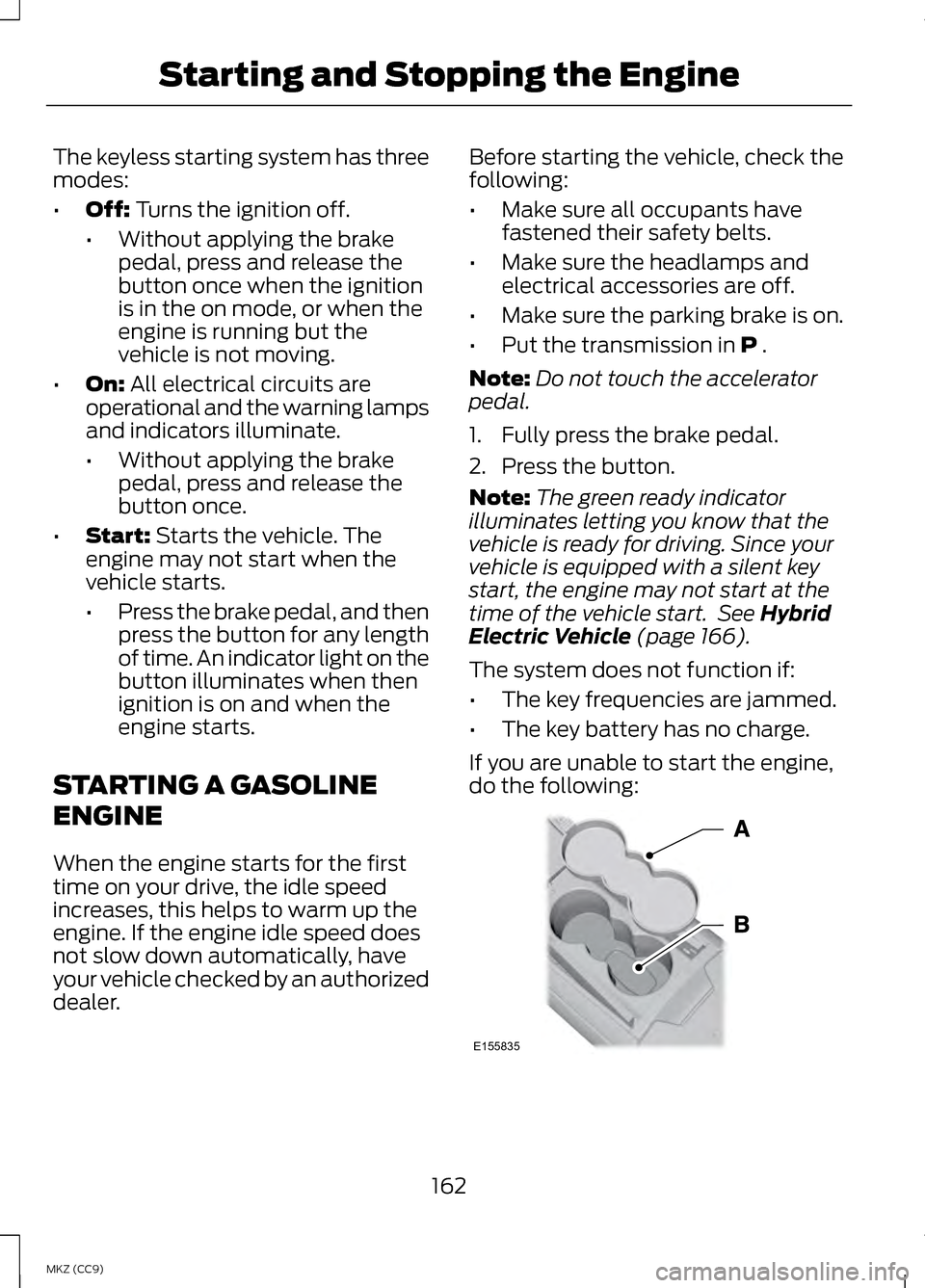
The keyless starting system has three
modes:
•
Off: Turns the ignition off.
• Without applying the brake
pedal, press and release the
button once when the ignition
is in the on mode, or when the
engine is running but the
vehicle is not moving.
• On:
All electrical circuits are
operational and the warning lamps
and indicators illuminate.
• Without applying the brake
pedal, press and release the
button once.
• Start:
Starts the vehicle. The
engine may not start when the
vehicle starts.
• Press the brake pedal, and then
press the button for any length
of time. An indicator light on the
button illuminates when then
ignition is on and when the
engine starts.
STARTING A GASOLINE
ENGINE
When the engine starts for the first
time on your drive, the idle speed
increases, this helps to warm up the
engine. If the engine idle speed does
not slow down automatically, have
your vehicle checked by an authorized
dealer. Before starting the vehicle, check the
following:
•
Make sure all occupants have
fastened their safety belts.
• Make sure the headlamps and
electrical accessories are off.
• Make sure the parking brake is on.
• Put the transmission in
P .
Note: Do not touch the accelerator
pedal.
1. Fully press the brake pedal.
2. Press the button.
Note: The green ready indicator
illuminates letting you know that the
vehicle is ready for driving. Since your
vehicle is equipped with a silent key
start, the engine may not start at the
time of the vehicle start. See
Hybrid
Electric Vehicle (page 166).
The system does not function if:
• The key frequencies are jammed.
• The key battery has no charge.
If you are unable to start the engine,
do the following: 162
MKZ (CC9) Starting and Stopping the EngineE155835
Page 165 of 475
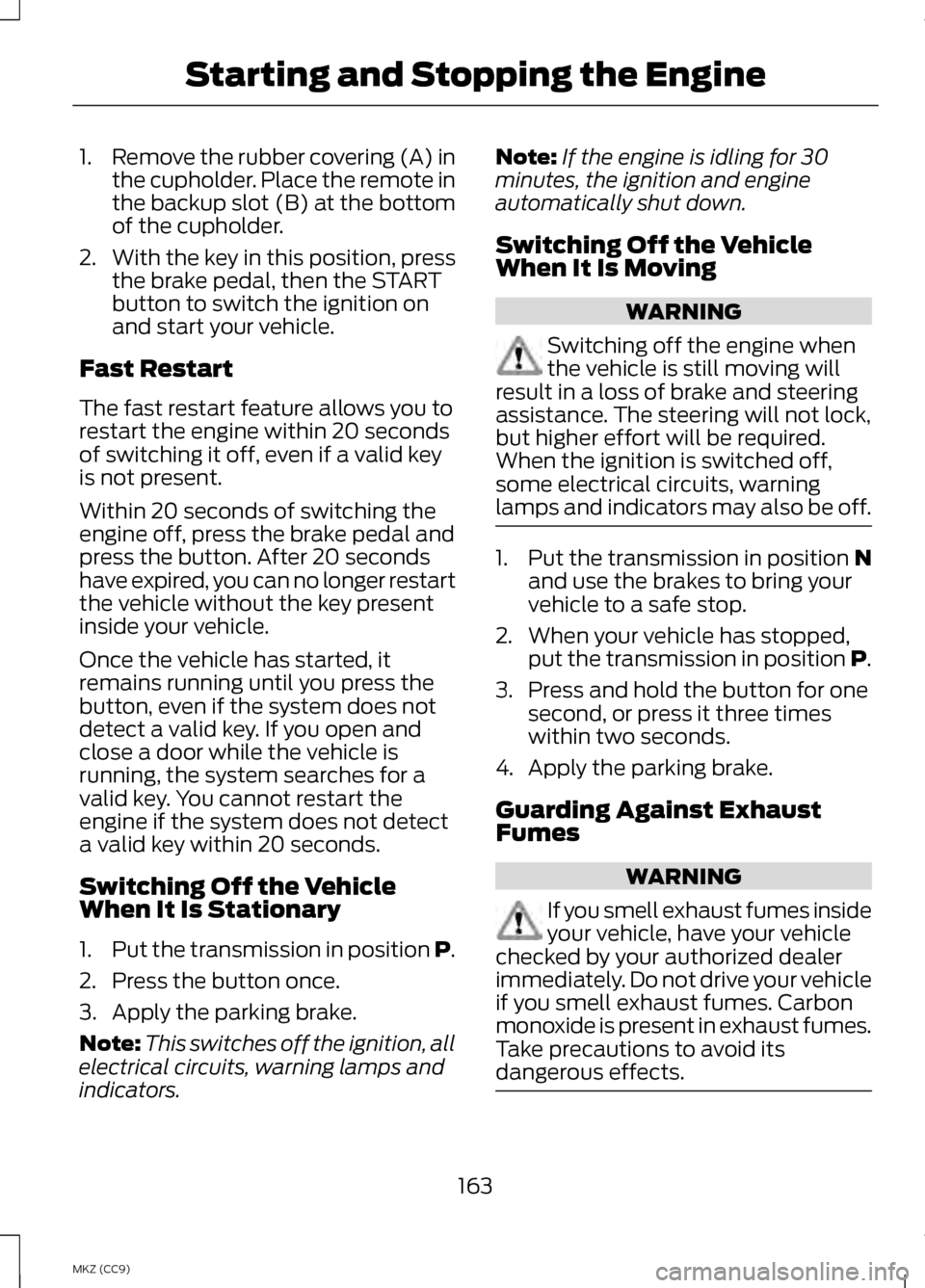
1.
Remove the rubber covering (A) in
the cupholder. Place the remote in
the backup slot (B) at the bottom
of the cupholder.
2. With the key in this position, press
the brake pedal, then the START
button to switch the ignition on
and start your vehicle.
Fast Restart
The fast restart feature allows you to
restart the engine within 20 seconds
of switching it off, even if a valid key
is not present.
Within 20 seconds of switching the
engine off, press the brake pedal and
press the button. After 20 seconds
have expired, you can no longer restart
the vehicle without the key present
inside your vehicle.
Once the vehicle has started, it
remains running until you press the
button, even if the system does not
detect a valid key. If you open and
close a door while the vehicle is
running, the system searches for a
valid key. You cannot restart the
engine if the system does not detect
a valid key within 20 seconds.
Switching Off the Vehicle
When It Is Stationary
1. Put the transmission in position P.
2. Press the button once.
3. Apply the parking brake.
Note: This switches off the ignition, all
electrical circuits, warning lamps and
indicators. Note:
If the engine is idling for 30
minutes, the ignition and engine
automatically shut down.
Switching Off the Vehicle
When It Is Moving WARNING
Switching off the engine when
the vehicle is still moving will
result in a loss of brake and steering
assistance. The steering will not lock,
but higher effort will be required.
When the ignition is switched off,
some electrical circuits, warning
lamps and indicators may also be off. 1.
Put the transmission in position N
and use the brakes to bring your
vehicle to a safe stop.
2. When your vehicle has stopped, put the transmission in position P.
3. Press and hold the button for one second, or press it three times
within two seconds.
4. Apply the parking brake.
Guarding Against Exhaust
Fumes WARNING
If you smell exhaust fumes inside
your vehicle, have your vehicle
checked by your authorized dealer
immediately. Do not drive your vehicle
if you smell exhaust fumes. Carbon
monoxide is present in exhaust fumes.
Take precautions to avoid its
dangerous effects. 163
MKZ (CC9) Starting and Stopping the Engine
Page 166 of 475
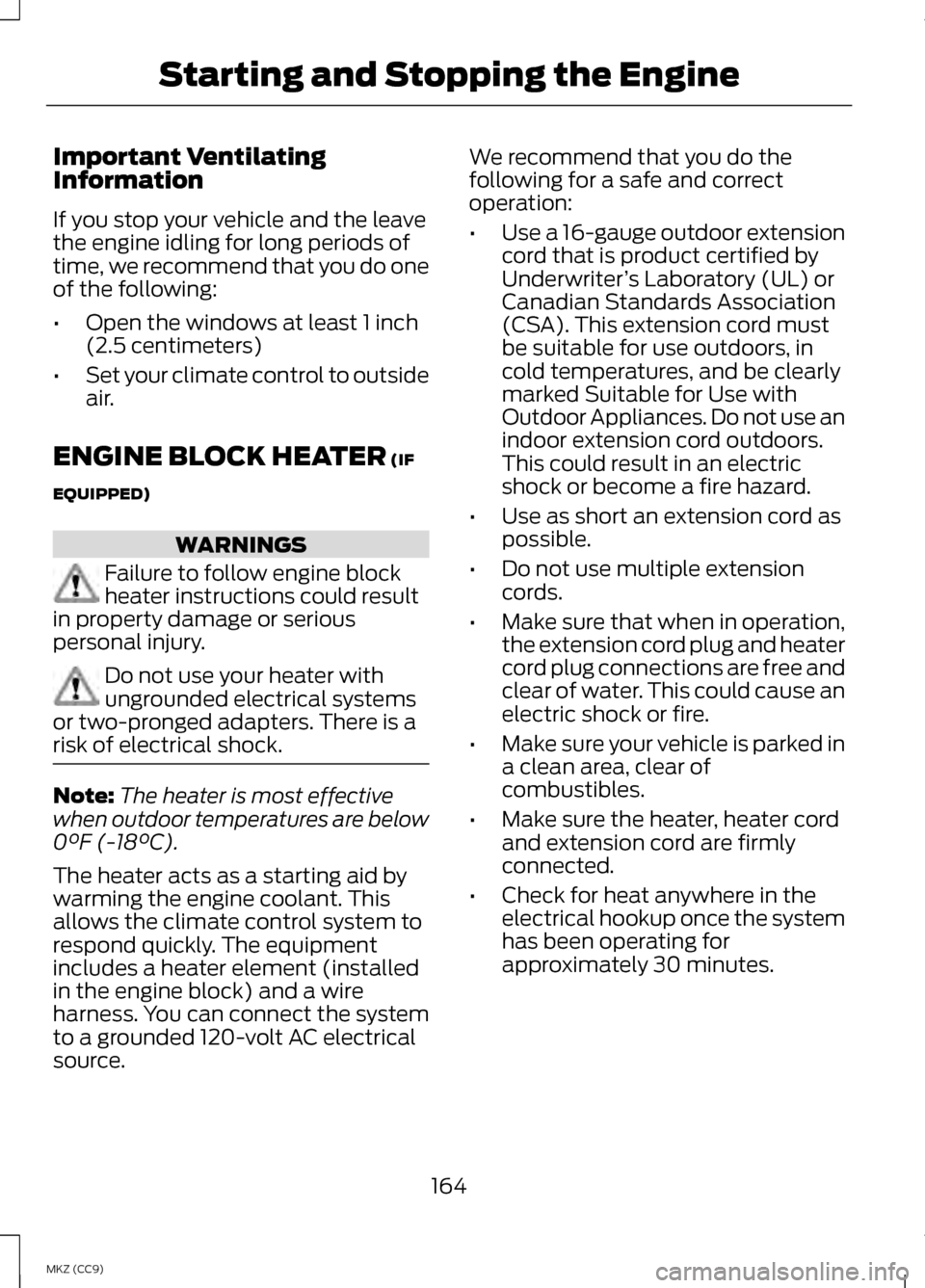
Important Ventilating
Information
If you stop your vehicle and the leave
the engine idling for long periods of
time, we recommend that you do one
of the following:
•
Open the windows at least 1 inch
(2.5 centimeters)
• Set your climate control to outside
air.
ENGINE BLOCK HEATER (IF
EQUIPPED) WARNINGS
Failure to follow engine block
heater instructions could result
in property damage or serious
personal injury. Do not use your heater with
ungrounded electrical systems
or two-pronged adapters. There is a
risk of electrical shock. Note:
The heater is most effective
when outdoor temperatures are below
0°F (-18°C).
The heater acts as a starting aid by
warming the engine coolant. This
allows the climate control system to
respond quickly. The equipment
includes a heater element (installed
in the engine block) and a wire
harness. You can connect the system
to a grounded 120-volt AC electrical
source. We recommend that you do the
following for a safe and correct
operation:
•
Use a 16-gauge outdoor extension
cord that is product certified by
Underwriter ’s Laboratory (UL) or
Canadian Standards Association
(CSA). This extension cord must
be suitable for use outdoors, in
cold temperatures, and be clearly
marked Suitable for Use with
Outdoor Appliances. Do not use an
indoor extension cord outdoors.
This could result in an electric
shock or become a fire hazard.
• Use as short an extension cord as
possible.
• Do not use multiple extension
cords.
• Make sure that when in operation,
the extension cord plug and heater
cord plug connections are free and
clear of water. This could cause an
electric shock or fire.
• Make sure your vehicle is parked in
a clean area, clear of
combustibles.
• Make sure the heater, heater cord
and extension cord are firmly
connected.
• Check for heat anywhere in the
electrical hookup once the system
has been operating for
approximately 30 minutes.
164
MKZ (CC9) Starting and Stopping the Engine
Page 167 of 475
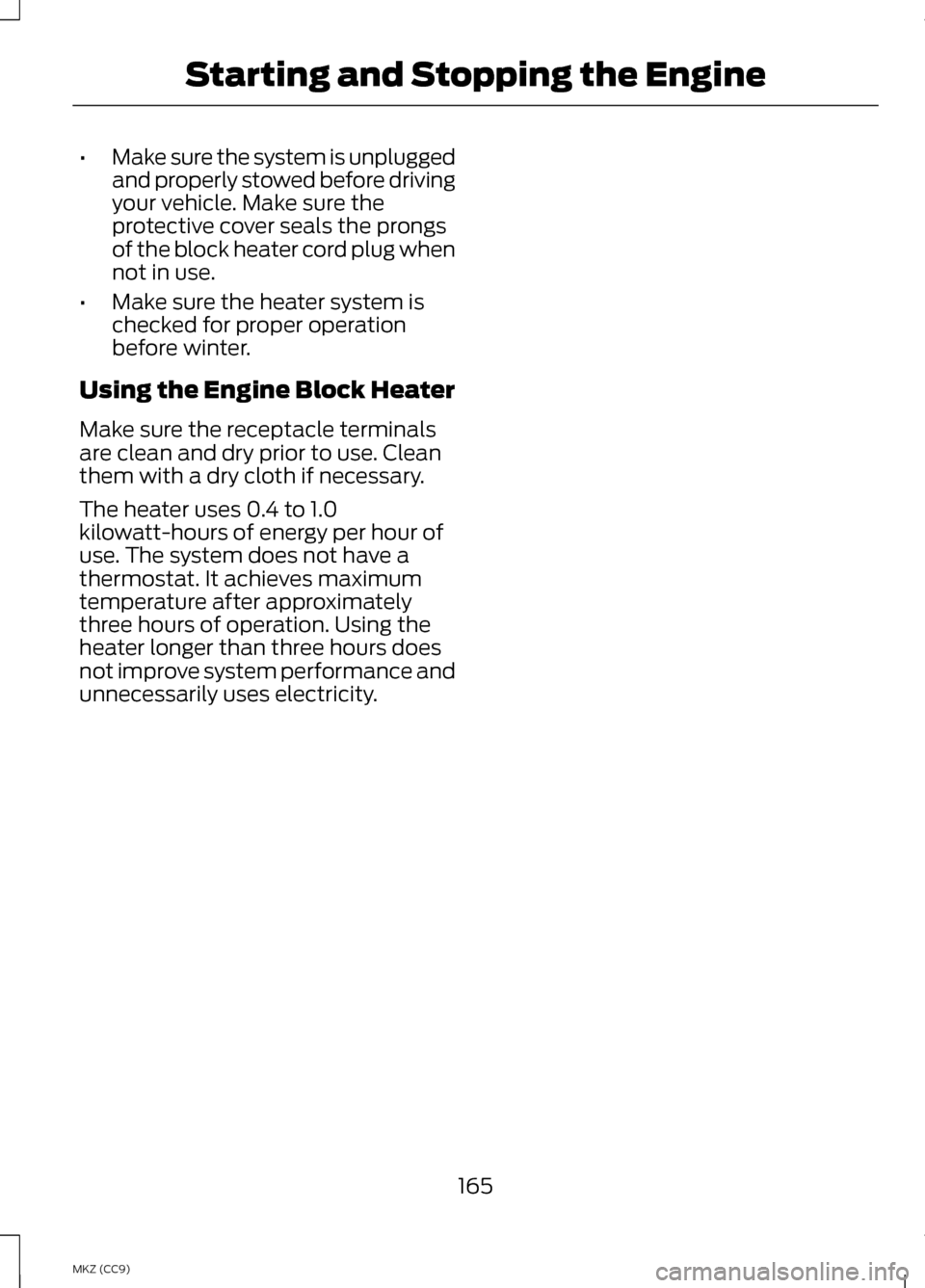
•
Make sure the system is unplugged
and properly stowed before driving
your vehicle. Make sure the
protective cover seals the prongs
of the block heater cord plug when
not in use.
• Make sure the heater system is
checked for proper operation
before winter.
Using the Engine Block Heater
Make sure the receptacle terminals
are clean and dry prior to use. Clean
them with a dry cloth if necessary.
The heater uses 0.4 to 1.0
kilowatt-hours of energy per hour of
use. The system does not have a
thermostat. It achieves maximum
temperature after approximately
three hours of operation. Using the
heater longer than three hours does
not improve system performance and
unnecessarily uses electricity.
165
MKZ (CC9) Starting and Stopping the Engine
Page 168 of 475
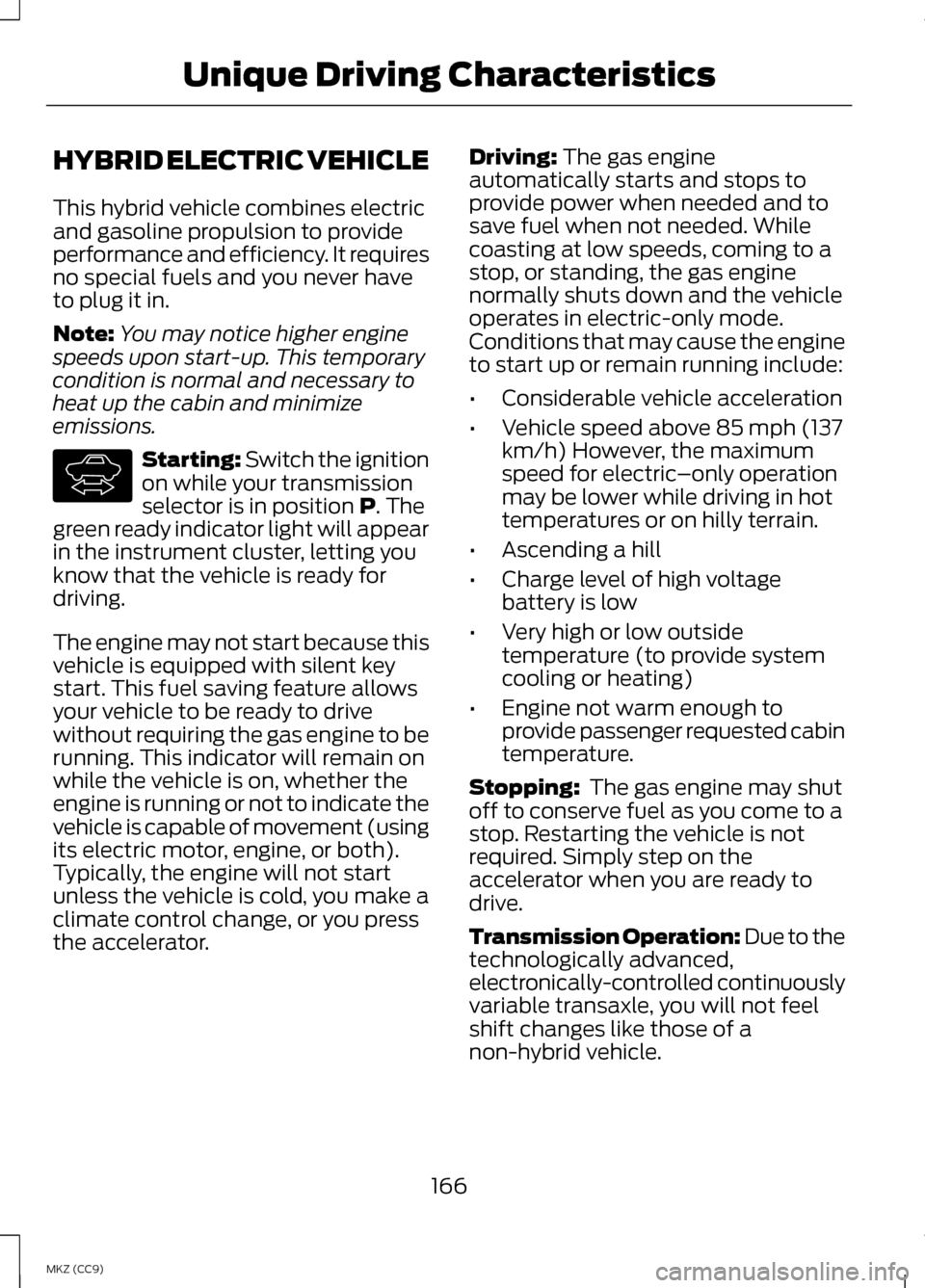
HYBRID ELECTRIC VEHICLE
This hybrid vehicle combines electric
and gasoline propulsion to provide
performance and efficiency. It requires
no special fuels and you never have
to plug it in.
Note:
You may notice higher engine
speeds upon start-up. This temporary
condition is normal and necessary to
heat up the cabin and minimize
emissions. Starting: Switch the ignition
on while your transmission
selector is in position P. The
green ready indicator light will appear
in the instrument cluster, letting you
know that the vehicle is ready for
driving.
The engine may not start because this
vehicle is equipped with silent key
start. This fuel saving feature allows
your vehicle to be ready to drive
without requiring the gas engine to be
running. This indicator will remain on
while the vehicle is on, whether the
engine is running or not to indicate the
vehicle is capable of movement (using
its electric motor, engine, or both).
Typically, the engine will not start
unless the vehicle is cold, you make a
climate control change, or you press
the accelerator. Driving:
The gas engine
automatically starts and stops to
provide power when needed and to
save fuel when not needed. While
coasting at low speeds, coming to a
stop, or standing, the gas engine
normally shuts down and the vehicle
operates in electric-only mode.
Conditions that may cause the engine
to start up or remain running include:
• Considerable vehicle acceleration
• Vehicle speed above 85 mph (137
km/h) However, the maximum
speed for electric –only operation
may be lower while driving in hot
temperatures or on hilly terrain.
• Ascending a hill
• Charge level of high voltage
battery is low
• Very high or low outside
temperature (to provide system
cooling or heating)
• Engine not warm enough to
provide passenger requested cabin
temperature.
Stopping:
The gas engine may shut
off to conserve fuel as you come to a
stop. Restarting the vehicle is not
required. Simply step on the
accelerator when you are ready to
drive.
Transmission Operation: Due to the
technologically advanced,
electronically-controlled continuously
variable transaxle, you will not feel
shift changes like those of a
non-hybrid vehicle.
166
MKZ (CC9) Unique Driving CharacteristicsE144692
Page 169 of 475
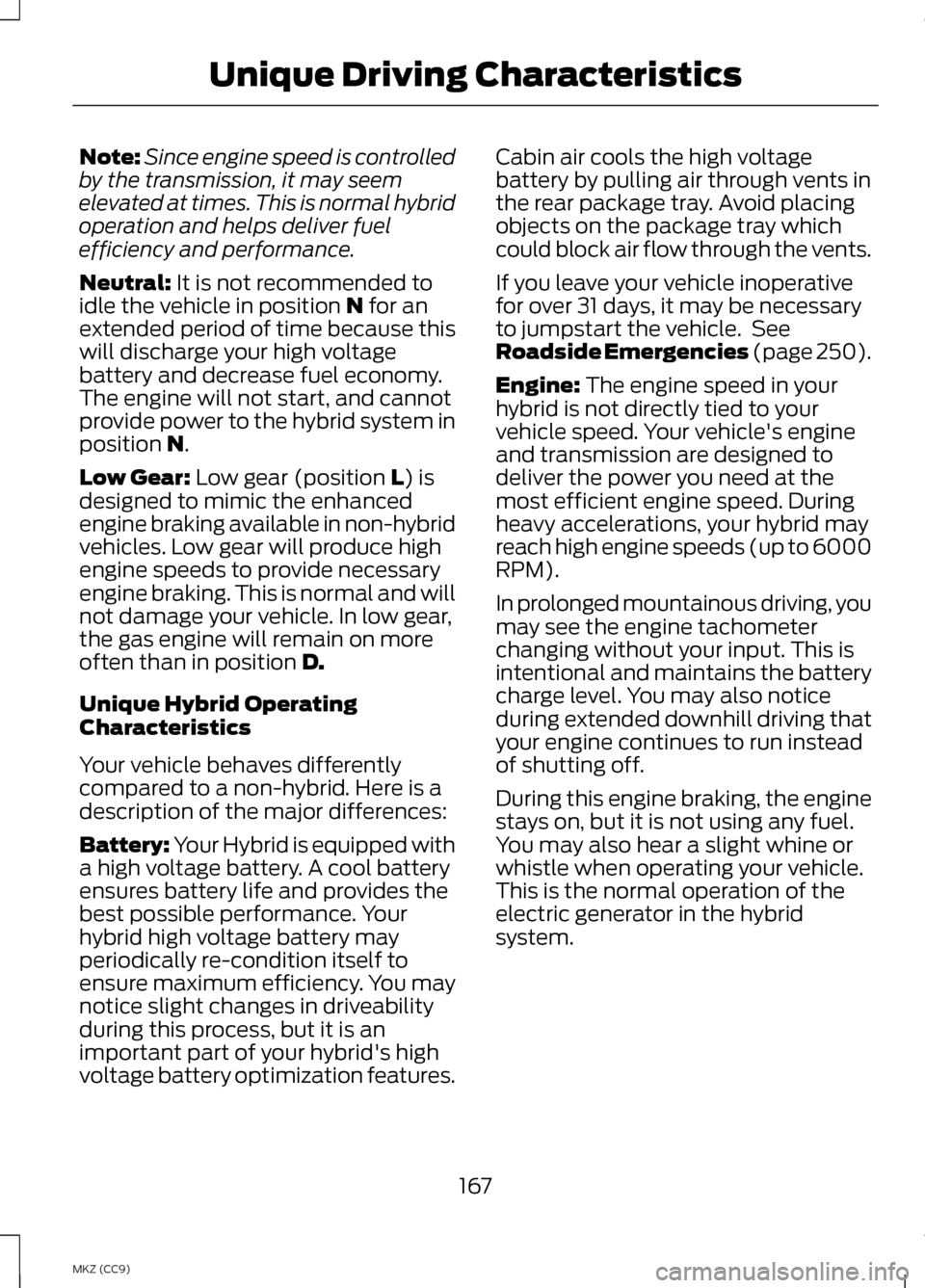
Note:
Since engine speed is controlled
by the transmission, it may seem
elevated at times. This is normal hybrid
operation and helps deliver fuel
efficiency and performance.
Neutral: It is not recommended to
idle the vehicle in position N for an
extended period of time because this
will discharge your high voltage
battery and decrease fuel economy.
The engine will not start, and cannot
provide power to the hybrid system in
position
N.
Low Gear:
Low gear (position L) is
designed to mimic the enhanced
engine braking available in non-hybrid
vehicles. Low gear will produce high
engine speeds to provide necessary
engine braking. This is normal and will
not damage your vehicle. In low gear,
the gas engine will remain on more
often than in position
D.
Unique Hybrid Operating
Characteristics
Your vehicle behaves differently
compared to a non-hybrid. Here is a
description of the major differences:
Battery: Your Hybrid is equipped with
a high voltage battery. A cool battery
ensures battery life and provides the
best possible performance. Your
hybrid high voltage battery may
periodically re-condition itself to
ensure maximum efficiency. You may
notice slight changes in driveability
during this process, but it is an
important part of your hybrid's high
voltage battery optimization features. Cabin air cools the high voltage
battery by pulling air through vents in
the rear package tray. Avoid placing
objects on the package tray which
could block air flow through the vents.
If you leave your vehicle inoperative
for over 31 days, it may be necessary
to jumpstart the vehicle. See
Roadside Emergencies
(page 250).
Engine:
The engine speed in your
hybrid is not directly tied to your
vehicle speed. Your vehicle's engine
and transmission are designed to
deliver the power you need at the
most efficient engine speed. During
heavy accelerations, your hybrid may
reach high engine speeds (up to 6000
RPM).
In prolonged mountainous driving, you
may see the engine tachometer
changing without your input. This is
intentional and maintains the battery
charge level. You may also notice
during extended downhill driving that
your engine continues to run instead
of shutting off.
During this engine braking, the engine
stays on, but it is not using any fuel.
You may also hear a slight whine or
whistle when operating your vehicle.
This is the normal operation of the
electric generator in the hybrid
system.
167
MKZ (CC9) Unique Driving Characteristics
Page 170 of 475
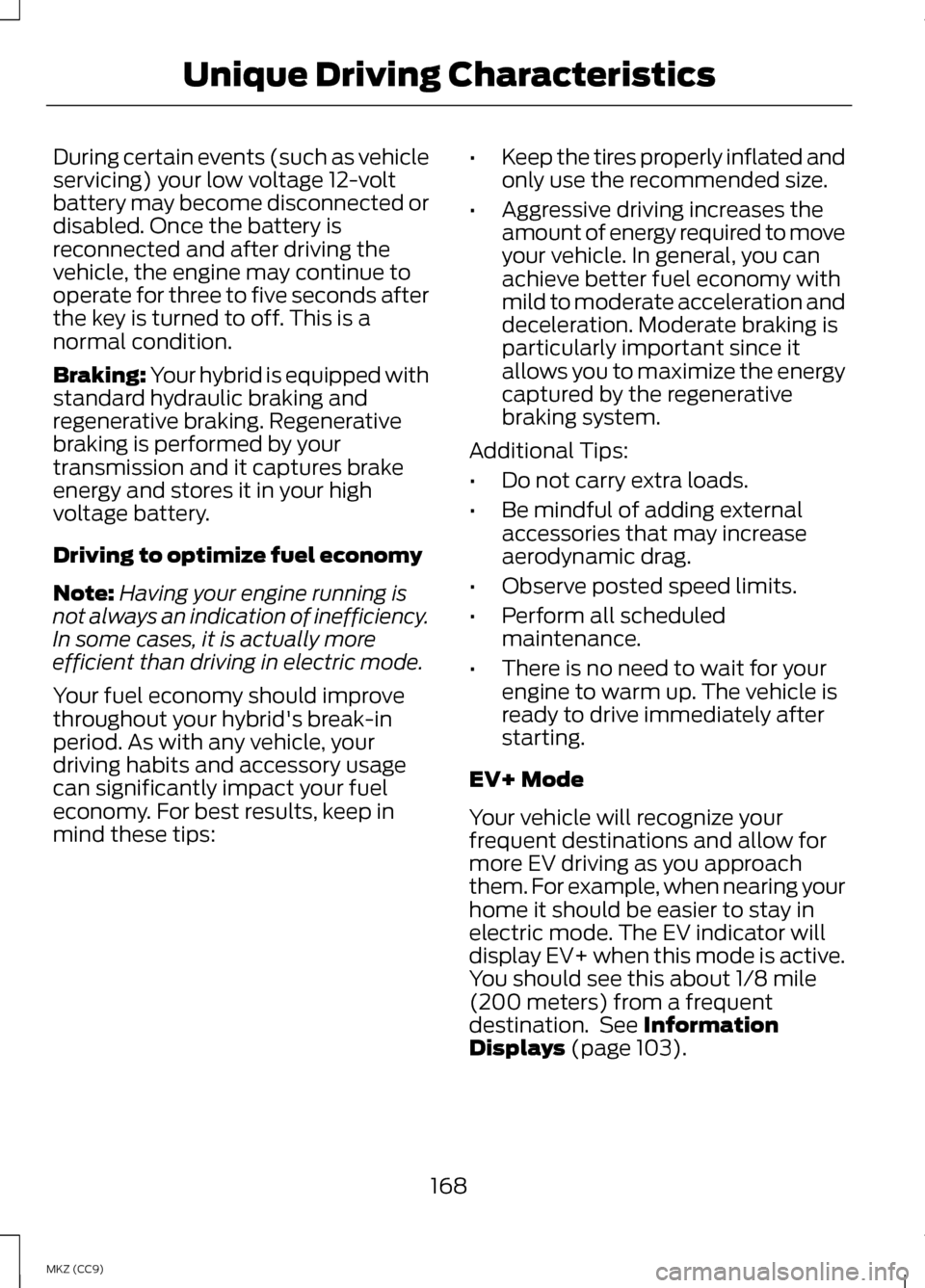
During certain events (such as vehicle
servicing) your low voltage 12-volt
battery may become disconnected or
disabled. Once the battery is
reconnected and after driving the
vehicle, the engine may continue to
operate for three to five seconds after
the key is turned to off. This is a
normal condition.
Braking: Your hybrid is equipped with
standard hydraulic braking and
regenerative braking. Regenerative
braking is performed by your
transmission and it captures brake
energy and stores it in your high
voltage battery.
Driving to optimize fuel economy
Note:
Having your engine running is
not always an indication of inefficiency.
In some cases, it is actually more
efficient than driving in electric mode.
Your fuel economy should improve
throughout your hybrid's break-in
period. As with any vehicle, your
driving habits and accessory usage
can significantly impact your fuel
economy. For best results, keep in
mind these tips: •
Keep the tires properly inflated and
only use the recommended size.
• Aggressive driving increases the
amount of energy required to move
your vehicle. In general, you can
achieve better fuel economy with
mild to moderate acceleration and
deceleration. Moderate braking is
particularly important since it
allows you to maximize the energy
captured by the regenerative
braking system.
Additional Tips:
• Do not carry extra loads.
• Be mindful of adding external
accessories that may increase
aerodynamic drag.
• Observe posted speed limits.
• Perform all scheduled
maintenance.
• There is no need to wait for your
engine to warm up. The vehicle is
ready to drive immediately after
starting.
EV+ Mode
Your vehicle will recognize your
frequent destinations and allow for
more EV driving as you approach
them. For example, when nearing your
home it should be easier to stay in
electric mode. The EV indicator will
display EV+ when this mode is active.
You should see this about 1/8 mile
(200 meters) from a frequent
destination. See Information
Displays (page 103).
168
MKZ (CC9) Unique Driving Characteristics